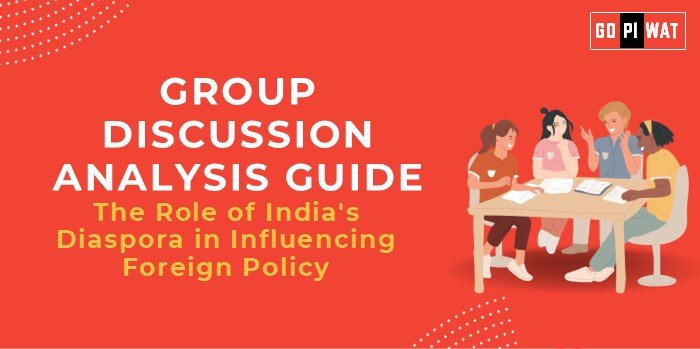📋 Group Discussion Analysis Guide
🌟 The Role of India’s Diaspora in Influencing Foreign Policy
🌐 Introduction to the Role of India’s Diaspora
Opening Context: India’s diaspora, comprising over 32 million people worldwide, is the largest globally, playing a critical role in shaping bilateral relationships, trade, and cultural diplomacy.
Topic Background: The Indian diaspora has evolved from being a labor-centric group to an influential community engaged in policymaking, technology, and international trade. Countries like the U.S., U.K., and UAE host substantial populations that influence policies at various levels.
📊 Quick Facts and Key Statistics
- 🌍 Diaspora Size: 32 million globally (MEA, 2023), the largest expatriate population in the world.
- 💸 Remittances: $111 billion in 2023, highest globally, bolstering India’s foreign reserves.
- ⚖️ Political Influence: Over 200 Indian-origin individuals in significant political positions globally, including Rishi Sunak (UK).
- 💻 Technology Contributions: 30% of Silicon Valley companies are founded or led by Indian-origin individuals.
- 📈 Economic Impact: Diaspora investments and businesses contribute significantly to bilateral trade and FDI.
🤝 Stakeholders and Their Roles
- 🏛️ Government of India: Engagement through programs like Pravasi Bharatiya Divas, facilitating diaspora’s contributions.
- 🌏 Host Countries: Provide platforms for diaspora influence in politics, economics, and culture.
- 🌐 Diaspora Organizations: Foster cultural connections and amplify India’s voice in international platforms.
- 🔗 Global Corporations: Benefit from the diaspora’s integration of Indian innovation with global markets.
📋 Achievements and Challenges
- 🏅 Achievements:
- Economic Contributions: India received the world’s highest remittances, contributing to financial stability.
- Diplomatic Leverage: Diaspora influences policies like U.S.-India relations (e.g., Indian Caucus in U.S. Congress).
- Soft Power Expansion: Promotion of Indian culture, yoga, and festivals, strengthening India’s global image.
- ⚠️ Challenges:
- Brain Drain: Skilled talent migration impacts domestic sectors.
- Integration Issues: Racism and policy discrimination in host countries.
- Limited Coordination: Lack of unified strategy to channel diaspora potential.
- 🌍 Global Comparisons:
- ✅ China: Utilizes its diaspora to drive investments and innovation.
- ✅ Israel: Engages diaspora to ensure strong global political support.
- 📚 Case Studies:
- U.S.-India Relations: Indian-Americans lobbying for policies like the Indo-Pacific strategy.
- UAE Collaborations: Strong economic ties driven by a 3.5 million Indian population.
📚 Structured Arguments for Discussion
- 👍 Supporting Stance: “The Indian diaspora is a strategic asset, driving foreign policy outcomes through economic, cultural, and political influence.”
- 👎 Opposing Stance: “Despite its potential, the diaspora’s influence is fragmented due to limited government coordination.”
- ⚖️ Balanced Perspective: “While the diaspora amplifies India’s global presence, realizing its full potential requires stronger policy frameworks and engagement.”
✅ Effective Discussion Approaches
- Opening Approaches:
- Start with statistics on diaspora contributions (e.g., remittances or political positions).
- Highlight a case study like Indian-Americans shaping U.S. policy.
- Counter-Argument Handling:
- Address limitations like integration challenges while suggesting solutions like improved consular services.
- Emphasize the diaspora’s increasing influence through data-backed rebuttals.
📊 Strategic Analysis of Strengths and Weaknesses
- 💪 Strengths:
- Economic remittances.
- Diplomatic leverage.
- Cultural influence globally.
- ⚡ Weaknesses:
- Fragmented policy coordination.
- Challenges in host country integration.
- 🚀 Opportunities:
- Expanding diaspora investment programs.
- Strengthening diaspora networks.
- 🌐 Threats:
- Rising xenophobia in host nations.
- Dependence on a few high-income regions.
🌍 Connecting with B-School Applications
- 📈 Real-World Applications: Projects in global business expansion, public diplomacy, or cross-border negotiations.
- 💬 Sample Interview Questions:
- “How can the diaspora act as a bridge in bilateral trade negotiations?”
- “What lessons can India learn from Israel’s diaspora engagement strategies?”
- 💡 Insights for Students:
- Analyze diaspora-driven investments for financial modeling.
- Study its role in multinational marketing or trade policy frameworks.


